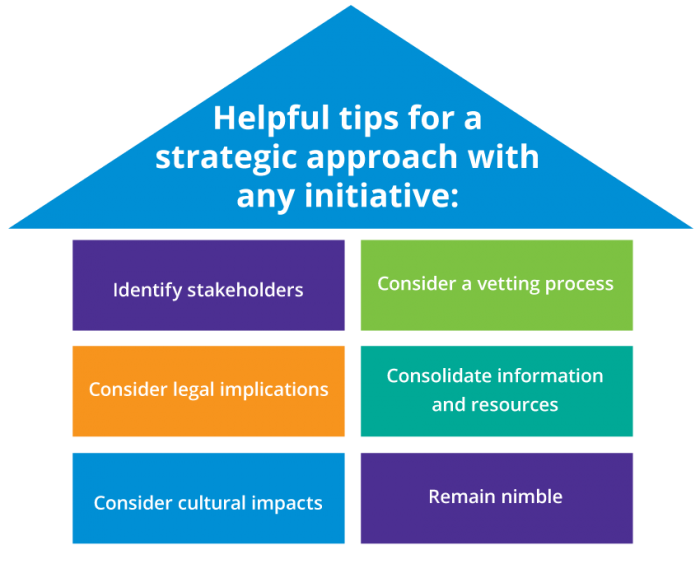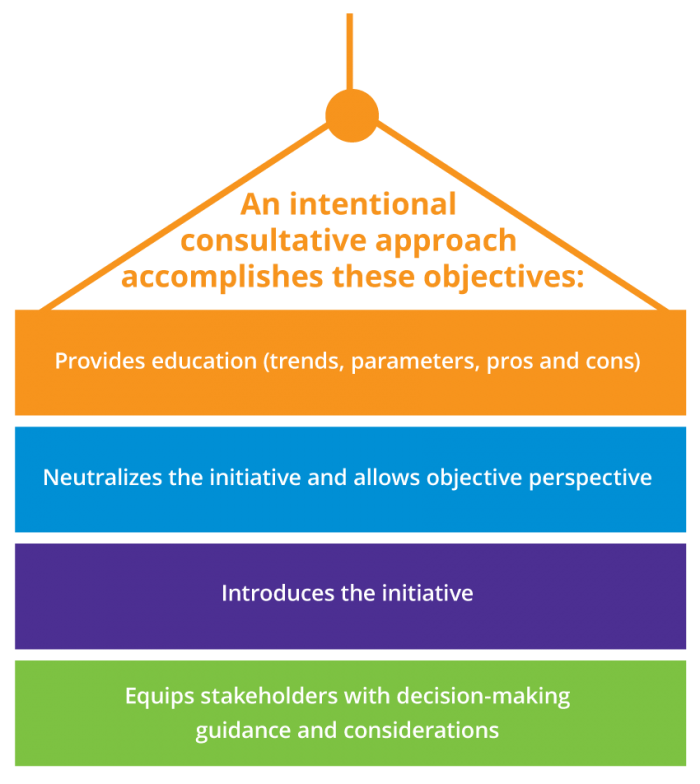A Consultative Approach: Kansas State University’s Framework for HR Success
In June 2021, Kansas State University (K-State)’s central HR office, Human Capital Services (HCS), received the email we had been waiting on for months: University leadership was giving HCS the green light to build and deploy a comprehensive remote work program and strategy to serve the institution’s faculty and staff. The twist? Our deadline was just a little over two weeks away.
Like most universities, K-State had a telecommuting policy in place for years, and it showed. We had known for some time that it needed a complete overhaul; however, due to COVID-19, other projects, which had been operating outside of our policy for over a year, took priority. With a return to “normal” on the horizon, we needed to evaluate how remote work would coexist with the future of work at K-State, both practically and culturally.
Overcoming Obstacles
For many institutions, the global pandemic highlighted or multiplied the various challenges we faced as HR professionals. K-State was no different. We were still grappling with how to approach what seemed like the monumental task of a policy overhaul and creating buy-in at a university where everyone had differing opinions about remote work — some very strong.
As we considered the best way to effectively engage our stakeholders, we recognized the importance of pausing to acknowledge and consider some challenging aspects of our situation:
Stakeholder engagement – HCS had a history of being seen as a department of “no,” which pushed many departments to seek workarounds or to not engage with us.
Communication – We knew we’d have to be intentional about clarity and providing the how and why behind guidance and decision-making.
Understanding of compliance – Overcoming facts versus myths centered around compliance topics is always a challenge.
Resistance – Given the varying opinions and fear around remote work, we needed to be able to overcome resistance and spark a willingness to explore the new and different.
Limited resources – The reality of operating with fewer staff, resources and additional time constraints meant we had to address this initiative without additional support.
Sense of urgency – We had a very short timeframe to provide a solution for remote work.
In addition to these challenges, this project also prompted specific concerns. We found ourselves asking, what does equity look like in a new remote work policy? How can we possibly address everyone’s desire for remote work flexibility? What internal/external impacts need to be recognized? And how do we address the entitlement to remote work some employees may feel since many are still working remotely?
Given the complexity and significance of the work ahead, we decided to leverage the proven consultative framework developed by HCS, which has served us well in the past when education and alignment were needed to advance an initiative. The Consultative Framework provides several key elements of support for any project:
- Structure to enhance the effectiveness of the project or initiative.
- A foundation of focus on the why and how of stakeholder engagement throughout the lifecycle of the project.
- A communication framework to ensure alignment across the institution.
A Consultative Framework
Thinking ahead to the outcomes and end state we were working toward, we didn’t want our stakeholders to say “HCS doesn’t understand our unit, and this won’t work for our team.” Our ultimate goal was to create and effectively roll out a program that was flexible enough to serve our university community and strong enough to preserve what was most important. The foundation of the Consultative Framework is based on four pillars: alignment of HR vision, project management, consultative approach and investment in partnerships.

Working through each of these components prompted us to acknowledge key contextual factors within our organization and guided us in designing our approach with those insights in mind. HCS has used this framework on a variety of initiatives in the past, and although each project looks different, it’s incredibly adaptable and has consistently improved our outcomes.

Alignment of HR Vision
It was tempting to jump right into discussion about the “what and how” of our project, especially because our timeframe was so short. However, we took the time to thoughtfully consider and articulate the reasons and intentions driving this major initiative. Without this reflection and an exploration of potential options, communicating the why and getting stakeholders to buy in could have been even more challenging. Creating alignment in our HR vision was necessary pre-work that framed and set the stage for each pillar of our framework.
These are a few questions that helped guide our discussion on the vision of the initiative:
- Why does this project matter?
- How does this project relate to and serve the mission and vision of our institution?
- What are the risks or consequences of inaction or making a poor decision?
- What might be advantages or disadvantages of pursuing various options?
- What is the ultimate goal or purpose of the effort?
HCS has used this framework on a variety of initiatives in the past, and although each project looks different, it’s incredibly adaptable and has consistently improved our outcomes.
Project Management
Given the complexity and scope of large-scale initiatives, it’s imperative that a detailed timeline is outlined from the start and maintained throughout the lifecycle of the project. Key components to include are the task, who is responsible, the purpose or objective of the task and the deadline. Mapping out tasks chronologically helps leaders organize their thinking and can assist in identifying the order in which key deliverables should be completed. This process can also help identify who (individuals, affinity groups, shared governance, etc.) need to be involved when and on what pieces of the project.
For our project, HCS created a simple spreadsheet in a shared folder that each member of our project team could reference and update as needed. Creating this chart forced us to plan our project from start to finish — working backward from our deadline to help us identify which actions needed to happen immediately and over the coming days. It allowed us to anticipate our needs and seek out partnerships and approvals in advance rather than getting caught up in administrative bottlenecks due to poor planning.
Consultative Approach
To consult effectively, your communication must not only reach your intended audience but also create a shared understanding.
A key component of the framework and the magic of its success is in the consultative approach. At its heart, this approach is what it looks like to be a strategic partner. Being a strategic partner means coming to the table with expertise and equipping leaders with the information and guidance they need to make the best decisions they can for their units. It means acknowledging that although we are HR experts, our partners are the experts in their business.
To consult effectively, your communication must not only reach your intended audience but also create a shared understanding. To create that shared understanding, your communication must be designed with care and intention. Word choice, tone, reading level, appropriate and relevant levels of detail, visual appeal and ease of presentation are all elements that impact the effectiveness of communication, whether written or spoken.
In addition to those elements, think about what the audience needs to learn or consider in order to take the desired action. Is prerequisite knowledge, context or framing needed? In most cases, one size does not fit all. Each audience should be able to clearly glean their own answer to the question “What’s in it for me?” from the information presented. Although each communication may need a bit of tweaking for its intended audience, all communications should be consistent in terms of reinforcing project goals and general tone.
Once a communication plan, messaging and media have been identified, it’s time to consider the consultation itself. There are several components to successful consultations with leaders:
- Education. What do leaders need to know about the situation? Maybe it’s regulations, trends, risk factors, pros and cons — whatever is going to help the stakeholders understand the why. It could be the why about the topic or even why they should care!
- Framing. This includes thoughtfully introducing the HR strategic initiative. In the case of HCS, our strategic initiative was to create clarity around our new remote work policy and procedures. We asked ourselves what is remote work and how will it be utilized at K-State? Be intentional with the who, what, when, where and why of the program.
- Guidance. HR should inform stakeholders of the guidance that we provide as they navigate the new and different. What considerations may impact decisions they make for their faculty and staff? Are there pitfalls to avoid?
In essence, as strategic HR partners, we’re saying “Here’s the situation, here are the options and here are things to consider when making decisions.” In other words, we aren’t making these decisions for the unit, their leaders are. HR’s role is to assist and be a partner.

Engaging with stakeholders early and often was a big win for us. Not only did that provide a positive rapport in the moment, but it also provided sustainable opportunities to calibrate and build relationships for trust in the future.
Investment in Partnerships
Understanding how people are going to receive your initiative is important. With remote work, people were nervous and on the fence. We knew that if we didn’t vet our process early, we would hear it after the initial work on our end (policy, forms, etc.) was released, and that would not have been productive.
Engaging with a very small, focused work group to assist with a review of our website and materials has been key to our success on the remote work initiative. A few potential partners for engagement to consider might include shared governance groups, general counsel, the president’s and provost’s offices and unit HR practitioners.
As mentioned previously, engaging with stakeholders early and often was a big win for us. Not only did that provide a positive rapport in the moment, but it also provided sustainable opportunities to calibrate and build relationships for trust in the future. This investment of time translates to partnerships in the future and communicates a message of approachability for HR.
Our stakeholders at various levels around the institution provided helpful insight that supported our approach, using words that were reflective of what we were striving for. K-State’s president recognized our work with this positive feedback: “Their approach was concise, thoughtful and strategic, resulting in a highly effective and successful implementation for K-State.”
With each application of the framework, we’ve further strengthened relationships with university leaders and added real strategic value across the institution.
A Trusted Method
In the end, we met our deadline and successfully launched a comprehensive remote work program with an extensive suite of tools, resources and education for all levels of our faculty and staff population. Our framework had come through for us again, providing the structure and formula to navigate another complex and large-scale HR initiative at our institution. With each application of the framework, we’ve further strengthened relationships with university leaders and added real strategic value across the institution. With no shortage of change and innovation in the future of work and higher education, we will have many opportunities to continue to leverage the consultative framework in the years ahead.
About the authors: Shanna Legleiter is associate vice president at Kansas State University, and Jennifer Locanthi is the former compensation and organizational effectiveness manager at Kansas State University and current field services director for the Society for Human Resource Management (SHRM).
©2022 Shanna Legleiter and Jennifer Locanthi. The text of this work is licensed under a Creative Commons BY-NC-ND 4.0 International License.

